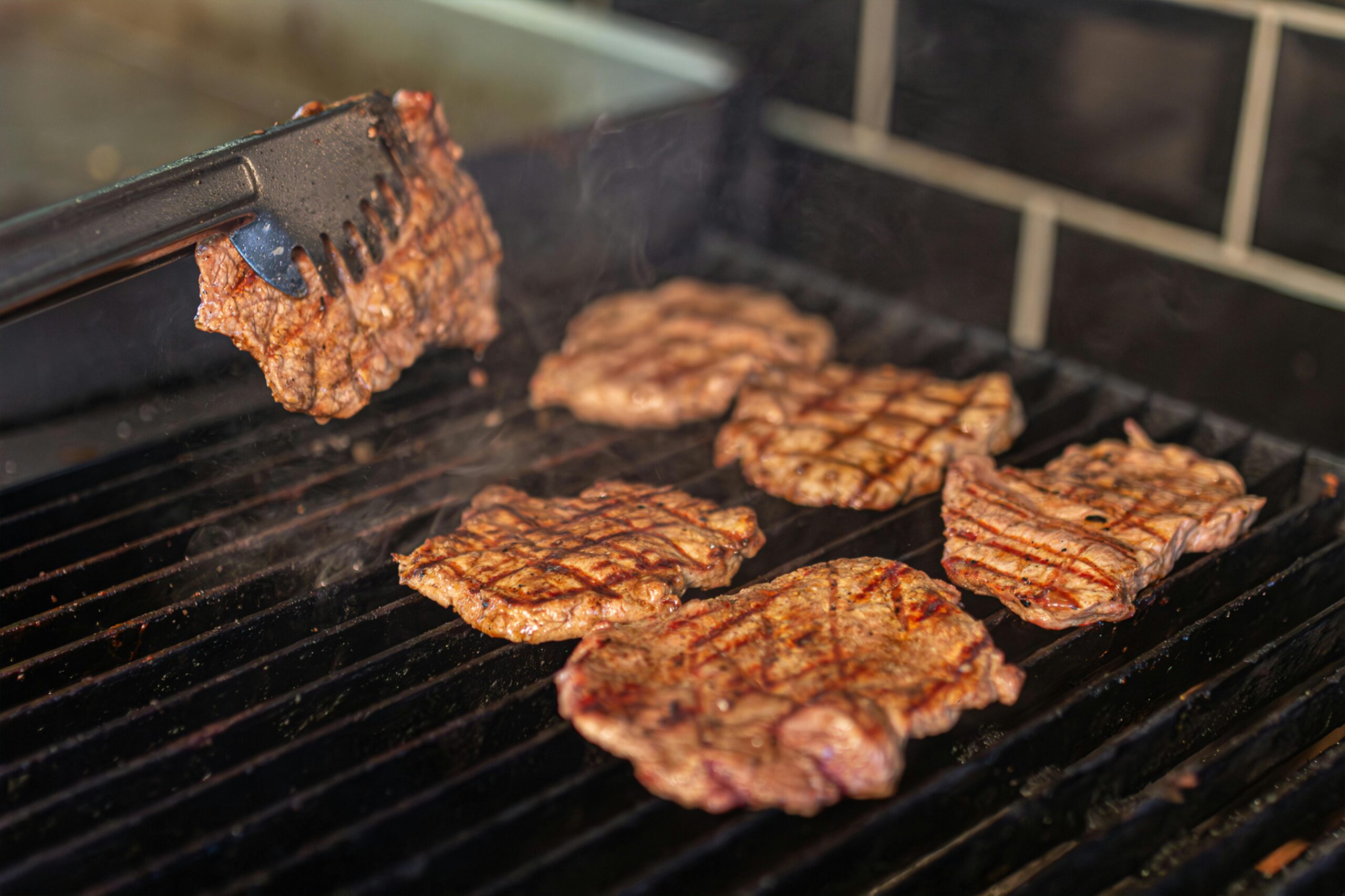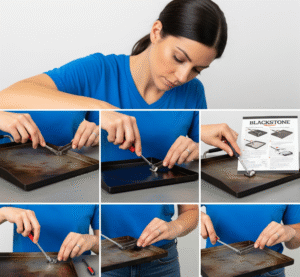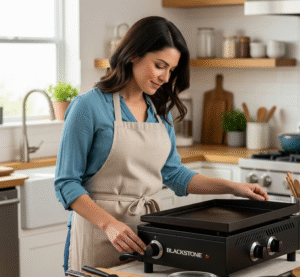😨 My First Mistake? Watching 5 YouTube Videos and Still Getting It Wrong
I’ll be honest: when I unboxed my brand new Blackstone griddle, I was pumped.
The sizzle, the surface, the potential for bacon at any time of day… it was love at first sight.
But then came the terrifying part:
“Season the griddle before first use.”
Wait—season it? Like a cast-iron skillet? What oil do I use? How many coats? Do I wipe it off or leave it on? Can it catch fire if I do it wrong?
I made a lot of mistakes in those first 24 hours (more on that later), but eventually, I figured it out. And today, I’m going to walk you through the exact process to season your Blackstone griddle like a pro — the very first time.
Because trust me — if you mess this up, you’ll get flaking, rusting, sticky spots… and regret. 🥴
Let’s not let that happen, okay?
Table of Contents

🛠️ What You’ll Need to Season Your Griddle
Before we dive in, grab the following:
- High smoke point oil – Flaxseed oil, grapeseed oil, or avocado oil
- Lint-free cloth or paper towels
- Tongs or heat-resistant gloves
- Griddle scraper (you’ll use this later, too)
- Patience (not optional 😅)
👉 Buy This Top-Rated Griddle Seasoning Oil on Amazon
👉 Grab a Griddle Scraper Tool Set for Beginners
🔥 Step-by-Step: How to Season Your Blackstone Griddle (Without Screwing It Up)
✅ Step 1: Clean the Griddle Surface Thoroughly
Even if your griddle is new, it may have factory residues or dust from packaging.
Here’s what I did:
- Fill a small bucket with warm, soapy water (use mild dish soap)
- Dip a clean towel and scrub the surface thoroughly
- Rinse with clean water and dry completely with paper towels
⚠️ Don’t skip this — seasoning on top of factory oil can cause sticking later.
✅ Step 2: Turn on the Heat — Get It Screaming Hot
Turn all the burners on high and leave the lid open.
Let the surface get extremely hot for 10–15 minutes until it changes color and begins to darken slightly.
That’s the surface oxidizing and preparing to bond with the oil.
It’ll look uneven. That’s fine.
✅ Step 3: Apply a Very Thin Layer of Oil
This is the most important part — less is more.
Using tongs and a folded paper towel or lint-free cloth, dip into your oil and rub a thin, even coat across the entire surface — including the corners and edges.
⚠️ Important: Don’t let oil pool anywhere. Wipe away excess!
👉 This Organic Avocado Oil Has a High Smoke Point and Works Great
✅ Step 4: Let It Smoke (And Stink) — That’s the Polymerization
Once the oil is applied, let the griddle heat for 15–20 minutes more.
You’ll see the oil begin to smoke heavily — this is called polymerization.
It’s when the oil bonds to the metal and forms that classic, black non-stick coating.
🔥 Don’t panic. It’s supposed to smoke like crazy!
When the smoke fades and the surface looks dry again, you’re ready for the next coat.
✅ Step 5: Repeat the Process 3–5 Times
Yep — one layer isn’t enough.
You’ll need at least 3 coats to create a proper non-stick layer. Some people go up to 6.
Here’s the cycle:
- Apply a thin layer of oil
- Let it smoke for 20 minutes
- Wait for the smoke to stop
- Repeat
Every time, your griddle should get darker, turning from silver → bronze → dark brown → almost black.
✅ Step 6: Let It Cool Naturally (Then Store It Right)
Once your final layer smokes out, turn off the burners and let your griddle cool completely.
Don’t throw cold water on it or scrub anything.
Let nature do its thing.
Once cooled, lightly coat it with one final paper-thin layer of oil to protect it from moisture and prevent rust.
Then, cover it!
👉 This Blackstone Griddle Cover Keeps It Rust-Free
🚫 What NOT to Do When Seasoning Blackstone
Here’s what I did wrong, so you don’t have to:
- ❌ I used olive oil (low smoke point — BAD idea)
- ❌ I poured oil straight from the bottle (too much)
- ❌ I left oil puddled in the corners — it turned sticky
- ❌ I didn’t heat it long enough before oiling
- ❌ I skipped seasoning the corners and edges
And guess what? My first cook? Eggs stuck like glue. 😤
💬 Final Thoughts: Seasoning = Love + Science
Seasoning your Blackstone griddle isn’t just a chore — it’s a relationship ritual.
It’s how you protect your griddle, improve cooking performance, and build that beautiful black patina that makes food practically float on the surface.
So take your time. Use the right oil. Keep it thin. Smoke it out. And do it a few times.
You only need to do it once properly… and your griddle will thank you for years.



